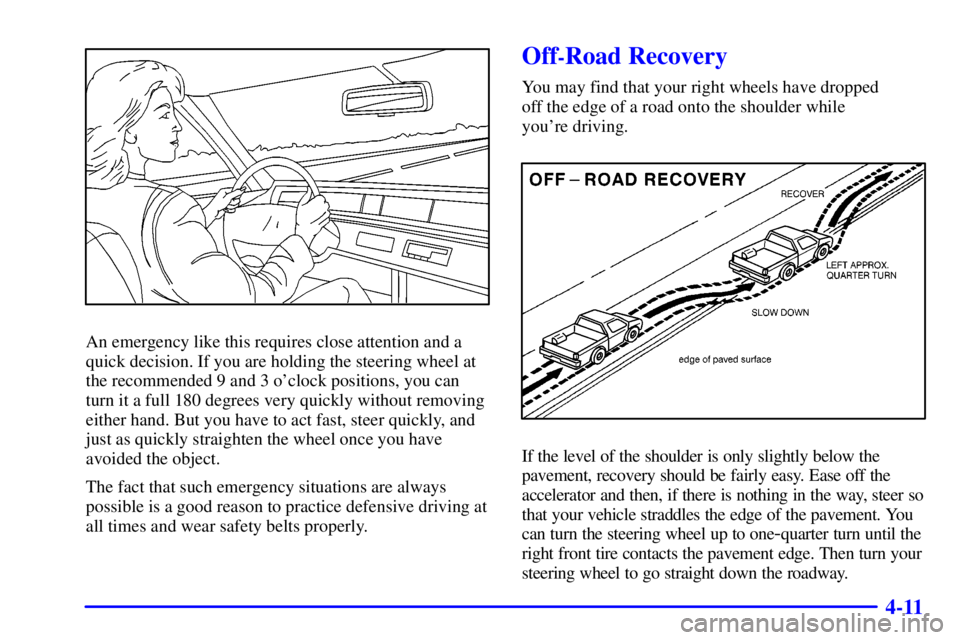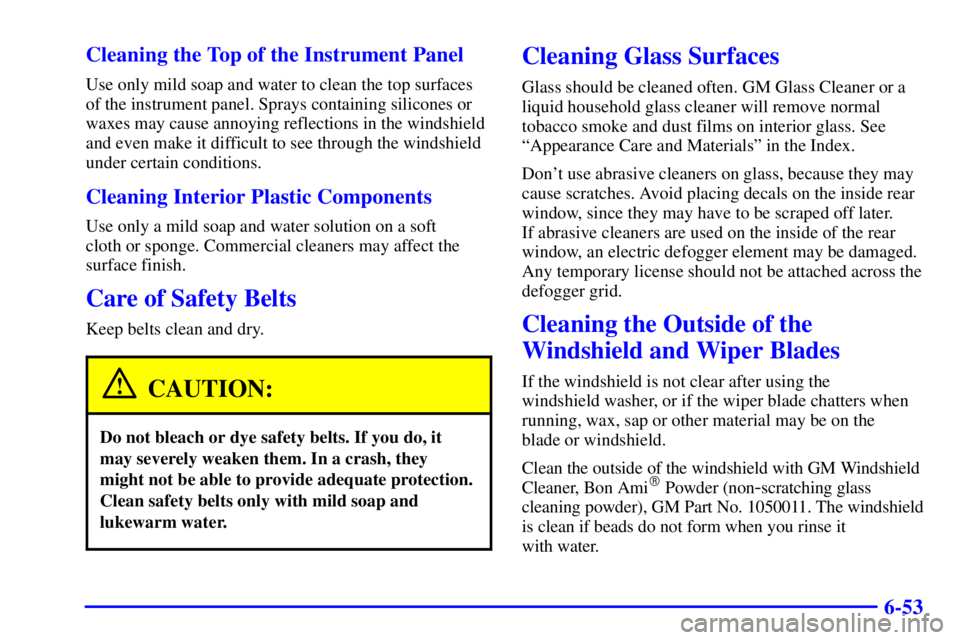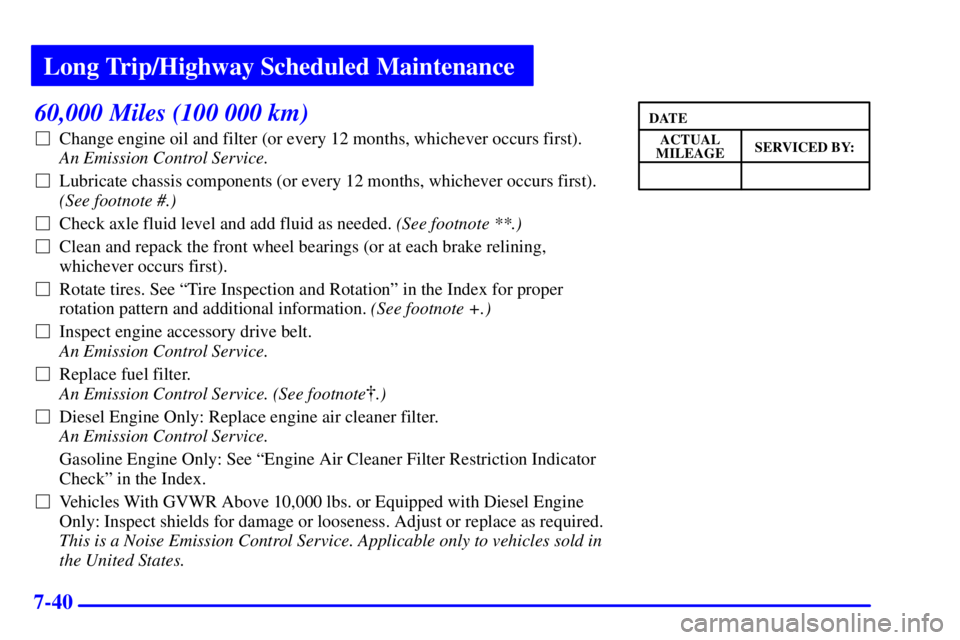Page 203 of 412

4-11
An emergency like this requires close attention and a
quick decision. If you are holding the steering wheel at
the recommended 9 and 3 o'clock positions, you can
turn it a full 180 degrees very quickly without removing
either hand. But you have to act fast, steer quickly, and
just as quickly straighten the wheel once you have
avoided the object.
The fact that such emergency situations are always
possible is a good reason to practice defensive driving at
all times and wear safety belts properly.
Off-Road Recovery
You may find that your right wheels have dropped
off the edge of a road onto the shoulder while
you're driving.
If the level of the shoulder is only slightly below the
pavement, recovery should be fairly easy. Ease off the
accelerator and then, if there is nothing in the way, steer so
that your vehicle straddles the edge of the pavement. You
can turn the steering wheel up to one
-quarter turn until the
right front tire contacts the pavement edge. Then turn your
steering wheel to go straight down the roadway.
Page 234 of 412

4-42 Maintenance When Trailer Towing
Your vehicle will need service more often when you're
pulling a trailer. See the Maintenance Schedule for more
on this. Things that are especially important in trailer
operation are automatic transmission fluid (don't overfill),
engine oil, axle lubricant, belt, cooling system and brake
system. Each of these is covered in this manual, and the
Index will help you find them quickly. If you're trailering,
it's a good idea to review these sections before you
start your trip.
Check periodically to see that all hitch nuts and bolts
are tight.
Trailer Wiring Harness
The optional heavy-duty trailer wiring package is a
seven
-wire harness assembly. The four-wire portion of
the harness assembly is stored under the vehicle, along
the driver's side rear corner of the frame rail. The
three
-wire portion of the harness assembly is stored in a
frame pocket under the rear of the vehicle, on the
driver's side. The heavy
-duty trailer wiring harness has
a 30
-amp feed wire. Both harnesses come without
connectors and should be wired by a qualified electrical
technician. The technician can use the following color
code chart when connecting the wiring harness to
your trailer.Four
-Wire Harness
�Light Green: Back
-up lamps
�Brown: Parking lamps
�Yellow: Left stoplamp and turn signal
�Dark Green: Right stoplamp and turn signal
Three
-Wire Harness
�Dark Blue: Use for electric trailer brakes
(seven
-wire harness only)
�Orange: Trailer accessory (seven
-wire harness only)
�White (heavy gage): Ground wire
Securely attach the harness to the trailer, then tape or
strap it to your vehicle's frame rail. Be sure you leave it
loose enough so the wiring doesn't bend or break, but
not so loose that it drags on the ground. Store the
harness in its original place. Wrap the harness together
and tie it neatly so it won't be damaged.
Page 315 of 412

6-46 Buying New Tires
To find out what kind and size of tires you need, look at
the Certification/Tire label.
The tires installed on your vehicle when it was new had
a Tire Performance Criteria Specification (TPC Spec)
number on each tire's sidewall. When you get new tires,
get ones with that same TPC Spec number. That way
your vehicle will continue to have tires that are designed
to give proper endurance, handling, speed rating,
traction, ride and other things during normal service on
your vehicle. If your tires have an all
-season tread
design, the TPC number will be followed by
an ªMSº (for mud and snow).
If you ever replace your tires with those not having a
TPC Spec number, make sure they are the same size,
load range, speed rating and construction type
(bias, bias
-belted or radial) as your original tires.
CAUTION:
Mixing tires could cause you to lose control while
driving. If you mix tires of different sizes or types
(radial and bias
-belted tires), the vehicle may not
handle properly, and you could have a crash.
Using tires of different sizes may also cause
damage to your vehicle. Be sure to use the same
size and type tires on all wheels.
CAUTION:
If you use bias-ply tires on your vehicle, the
wheel rim flanges could develop cracks after
many miles of driving. A tire and/or wheel could
fail suddenly, causing a crash. Use only radial
-ply
tires with the wheels on your vehicle.
Page 322 of 412

6-53 Cleaning the Top of the Instrument Panel
Use only mild soap and water to clean the top surfaces
of the instrument panel. Sprays containing silicones or
waxes may cause annoying reflections in the windshield
and even make it difficult to see through the windshield
under certain conditions.
Cleaning Interior Plastic Components
Use only a mild soap and water solution on a soft
cloth or sponge. Commercial cleaners may affect the
surface finish.
Care of Safety Belts
Keep belts clean and dry.
CAUTION:
Do not bleach or dye safety belts. If you do, it
may severely weaken them. In a crash, they
might not be able to provide adequate protection.
Clean safety belts only with mild soap and
lukewarm water.
Cleaning Glass Surfaces
Glass should be cleaned often. GM Glass Cleaner or a
liquid household glass cleaner will remove normal
tobacco smoke and dust films on interior glass. See
ªAppearance Care and Materialsº in the Index.
Don't use abrasive cleaners on glass, because they may
cause scratches. Avoid placing decals on the inside rear
window, since they may have to be scraped off later.
If abrasive cleaners are used on the inside of the rear
window, an electric defogger element may be damaged.
Any temporary license should not be attached across the
defogger grid.
Cleaning the Outside of the
Windshield and Wiper Blades
If the windshield is not clear after using the
windshield washer, or if the wiper blade chatters when
running, wax, sap or other material may be on the
blade or windshield.
Clean the outside of the windshield with GM Windshield
Cleaner, Bon Ami
� Powder (non-scratching glass
cleaning powder), GM Part No. 1050011. The windshield
is clean if beads do not form when you rinse it
with water.
Page 345 of 412

Scheduled Maintenance
7-6
Short Trip/City Intervals
Every 24,000 Miles (40 000 km): Diesel Engine Only:
Fuel Cap Replacement, if driving in dusty conditions.
Every 30,000 Miles (50 000 km): Diesel Engine
Only: Engine Air Cleaner Filter Replacement.
Fuel Filter Replacement.
Every 50,000 Miles (83 000 km): Automatic
Transmission Service (vehicles over 8600 GVWR
or driven under severe conditions or equipped with
diesel engine).
Every 60,000 Miles (100 000 km): Engine Accessory
Drive Belt Inspection. If Equipped: Exhaust Gas
Recirculation System Inspection. Gasoline Engine
Only: Evaporative Control System Inspection.
Diesel Engine Only: Crankcase Depression Regulator
Valve (CDRV) System Check.
Short Trip/City Intervals
Every 100,000 Miles (166 000 km): Gasoline Engine
Only: Spark Plug Wire Inspection. Gasoline Engine
Only: Spark Plug Replacement. Gasoline Engine
Only: Automatic Transmission Service (normal
conditions). Gasoline Engine Only: Positive
Crankcase Ventilation (PCV) Valve Inspection.
Every 150,000 Miles (240 000 km): Cooling System
Service (or every 60 months, whichever occurs first).
These intervals only summarize maintenance services.
Be sure to follow the complete scheduled maintenance
on the following pages.
Page 347 of 412

Scheduled Maintenance
7-8
Long Trip/Highway Intervals
Every 50,000 Miles (83 000 km): Automatic
Transmission Service (vehicles over 8600 GVWR
or driven under severe conditions or equipped with
diesel engine).
Every 60,000 Miles (100 000 km): Engine Accessory
Drive Belt Inspection. If Equipped: Exhaust Gas
Recirculation System Inspection. Gasoline Engine
Only: Evaporative Control System Inspection.
Diesel Engine Only: Crankcase Depression Regulator
Valve (CDRV) System Check.
Long Trip/Highway Intervals
Every 100,000 Miles (166 000 km): Gasoline Engine
Only: Spark Plug Wire Inspection. Gasoline Engine
Only: Spark Plug Replacement. Gasoline Engine
Only: Automatic Transmission Service (normal
conditions). Gasoline Engine Only: Positive
Crankcase Ventilation (PCV) Valve Inspection.
Every 150,000 Miles (240 000 km): Cooling System
Service (or every 60 months, whichever occurs first).
These intervals only summarize maintenance services.
Be sure to follow the complete scheduled maintenance
on the following pages.
Page 361 of 412

Short Trip/City Scheduled Maintenance
7-22
60,000 Miles (100 000 km)
�Change engine oil and filter (or every 3 months, whichever occurs first).
An Emission Control Service.
�Lubricate chassis components (or every 3 months, whichever occurs first).
(See footnote #.)
�Check axle fluid level and add fluid as needed. (See footnote **.)
�Clean and repack the front wheel bearings (or at each brake relining,
whichever occurs first).
�Vehicles With GVWR Above 10,000 lbs. or Equipped with Diesel Engine
Only: Inspect shields for damage or looseness. Adjust or replace as required.
This is a Noise Emission Control Service. Applicable only to vehicles sold in
the United States.
�Inspect engine accessory drive belt.
An Emission Control Service.
�Replace fuel filter.
An Emission Control Service. (See footnote�.)
�If Equipped: Conduct Exhaust Gas Recirculation (EGR) system inspection as
described in the service manual.
An Emission Control Service. (See footnote �.)ACTUAL
SERVICED BY:MILEAGE
DATE
Page 379 of 412

Long Trip/Highway Scheduled Maintenance
7-40
60,000 Miles (100 000 km)
�Change engine oil and filter (or every 12 months, whichever occurs first).
An Emission Control Service.
�Lubricate chassis components (or every 12 months, whichever occurs first).
(See footnote #.)
�Check axle fluid level and add fluid as needed. (See footnote **.)
�Clean and repack the front wheel bearings (or at each brake relining,
whichever occurs first).
�Rotate tires. See ªTire Inspection and Rotationº in the Index for proper
rotation pattern and additional information. (See footnote +.)
�Inspect engine accessory drive belt.
An Emission Control Service.
�Replace fuel filter.
An Emission Control Service. (See footnote�.)
�Diesel Engine Only: Replace engine air cleaner filter.
An Emission Control Service.
Gasoline Engine Only: See ªEngine Air Cleaner Filter Restriction Indicator
Checkº in the Index.
�Vehicles With GVWR Above 10,000 lbs. or Equipped with Diesel Engine
Only: Inspect shields for damage or looseness. Adjust or replace as required.
This is a Noise Emission Control Service. Applicable only to vehicles sold in
the United States.ACTUAL
SERVICED BY:MILEAGE
DATE